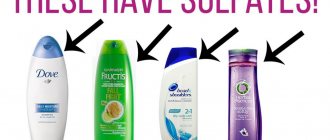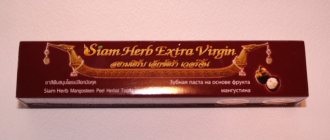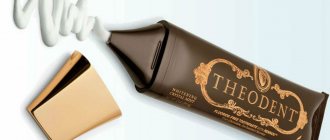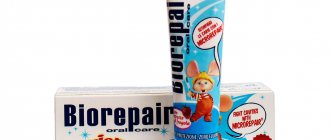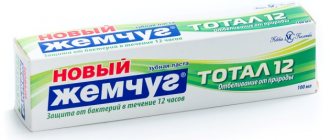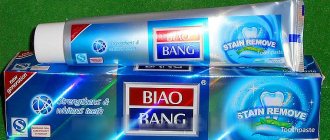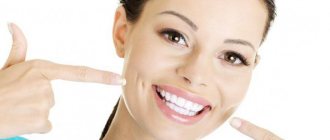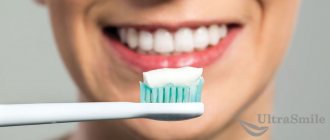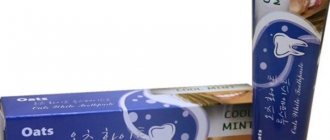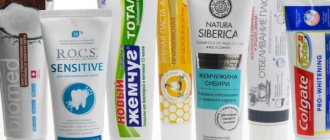It is impossible to maintain healthy teeth into old age without proper care for them. Among the variety of types of care products, paste comes first. It freshens breath and cleans teeth from food debris.
Depending on the type, the product solves many problems: bleeding and sore gums, plaque and the formation of harmful microorganisms.
But, despite all the advantages, the product can cause damage to health due to the content of chemical compounds such as lauryl sulfate and sodium laureth sulfate. Knowing which elements in dental care products should be avoided, you can protect your body from their negative effects.
Composition of toothpastes
The contents of pastes vary depending on the manufacturer, price and type. In addition to water, the main components of hygienic, therapeutic, preventive and specialized products are abrasive substances (aluminosilicates, silicon dioxide, calcium carbonate). They perform the main function of all toothpastes - cleaning and polishing teeth.
Specialized products are divided into:
- Anti-caries . They contain fluorides, xylitol, calcium glycerophosphate, phosphorus, and sodium bicarbonate.
- Pastes for sensitive teeth . Contains potassium chloride and nitrate, silicon oxide, strontium chloride.
- Anti-inflammatory . May include aluminum lactate, herbal extracts, hexiditin, chlorhexidine, triclosan.
- Whitening . Produced with silicon hydroxide, sodium and potassium pyrophosphates.
- Sorption . The active ingredient is enterosgel.
Most pastes include viscosity agents, colors and flavors. The latter can be natural (essential oils, menthol, limonin) and artificial.
Foam is created by surfactants, the use of which in products is permitted in an amount of no more than 2%. Of these, manufacturers give preference to sodium lauryl and sodium laureth sulfates. Binders (pectin, glycerin, dextran, cellulose) help to give the paste uniformity.
Children's products
Children's teeth require careful care and protection, so hygiene products for children need to be selected especially carefully.
PRESIDENT Baby
This Italian brand is ideal for children from the appearance of their first teeth to three or four years of age. A distinctive feature is a pleasant raspberry taste.
Provides enamel strengthening and caries prevention, normalizes acid balance, and is harmless if accidentally swallowed. The advantage is a rich composition, the disadvantage is the high price.
You can buy this Italian product for 110 rubles (30 ml tube).
Gel with calendula “Weleda”
The product consists of plant components: calendula extract, algae, mint, oils and refreshing elements.
The gel helps remove plaque and soothe inflammation of the gums, but is not aimed at preventing caries. This fact and the high cost are significant disadvantages.
It is recommended to use the gel alternating with other oral hygiene products containing calcium.
The main advantages of the gel are anti-inflammatory and antibacterial properties.
You can buy the gel for 250 – 300 rubles (volume 50 ml).
Disney Baby from JSC Svoboda
Disney Baby is produced in Russia in two flavors - banana and strawberry. Suitable for children from birth, does not contain allergens, is harmless if swallowed.
A variety of active ingredients in the form of silicon dioxide, calcium gluconate, xylitol, plant extracts (chamomile and sage) guarantee high-quality oral hygiene for children.
Helps soothe gums during teething. Has bright colorful packaging with Disney characters; cost - from 90 rubles (62 g) .
SPLAT Juicy Set
This Russian product is produced specifically for children and adults, and includes a set consisting of three products of different tastes.
They contain an easily digestible form of calcium, which quickly restores damaged enamel.
The components of the product also prevent stomatitis, caries, and inflammation. The set includes the following flavors: kiwi and strawberry, chocolate flavor and peach aroma.
Price – from 250 rubles for 3 pastes of 35 ml each.
SPLAT Junior
Suitable for children under 5 years old, has a delicate taste and is safe to swallow. The enzymes and vitamins included in the composition are aimed at removing contaminants, bacterial protection, and also take into account the characteristics of baby teeth.
Calcium compounds promote the formation of healthy enamel. An important advantage of the product is the function of protection against stomatitis, as well as a calming effect on inflammation, which is especially important during teething.
For the convenience of parents, each package contains a finger brush specifically for babies.
The cost of the product is from 150 rubles (50 ml).
ROCS – PRO Baby
The product is aimed at caring for children’s very first baby teeth and consists almost exclusively of natural ingredients. Due to its low abrasiveness, it very gently cleanses the enamel without causing irritation or damaging the gums.
Calcium glycerophosphate is responsible for mineralization, and xylitol fights bacteria, normalizing microflora.
The product is quite expensive compared to a similar, but higher quality Italian product of the PRESIDENT brand for children.
Cost – from 210 rubles per tube of 45 ml.
ROCS baby – fragrant chamomile
The paste is based on active substances - chamomile extract, which protects against acid xylitol, as well as soothing seaweed.
The abrasiveness index RDA 19 gently and carefully cleanses enamel from plaque, eliminates acids, and ensures the prevention of caries. For children up to three years old.
The disadvantage is the complete absence of calcium in the composition, which means that the product only cleanses, but does not strengthen. Plus - pleasant taste, harmless when swallowed.
Cost 45 ml - from 170 rubles.
ROCS kids – Barberry
This product is designed for preschool children (3 years - 7 years). The components take into account the characteristics of baby teeth and their weak coating.
Calcium glycerophosphate is responsible for the formation and strengthening of the surface, and xylitol is responsible for the correct acid balance.
The components provide not only gentle cleansing, but also anti-caries protection, as well as a refreshing effect. Children like the original taste, but the cost of the paste is high.
Production takes place in Russia; you can purchase a 45 ml package from 190 rubles.
Let's find out the advantages and disadvantages of using the Curaprox toothbrush. In this review we will talk about manufacturers of whitening powders.
And here: https://dentist-pro.ru/krasota-i-uxod/narashhivanie/sposoby-protivopokazaniya-ceny.html - it tells not only about the cost of teeth extensions, but also about the features of the procedure itself.
What is sodium lauryl sulfate
Sodium lauryl sulfate (SLS) is an anionic surfactant whose main properties are to dissolve fats, cleanse, form foam and wet.
The cleansing function of lauryl sulfate is its ability to oxidize, which is why after using cosmetics with SLS a film remains on the skin and mucous membranes. Its effects are manifested by the following symptoms:
- rash;
- redness;
- irritation;
- peeling;
- allergic reactions.
In addition, the water-fat balance of the skin is disrupted and sebum production is stimulated. Lauryl sulfate easily enters the internal organs through the epidermis, accumulating in them. The kidneys, heart, liver, brain and especially the eyes can be affected. The chemical affects the protein tissue of the organs of vision, causing cataracts.
SLS has not been proven to be carcinogenic, but it is known that it can cause cancer when it reacts with other substances. In men, SLS can lead to decreased fertility.
Foaming components
The key functions of such components are to moisturize the surface of the teeth, create foam and maintain an even consistency of the composition for easier cleaning.
The most well-known foaming agent is sodium lauryl sulfate (SLS, E 487). Unfortunately, it does more harm than good. This component is toxic, it has a drying effect on the mucous membrane, and in addition, it can cause allergies. However, it is contained in pastes of the brands Colgate, Aquafresh, Glister, Blen-da-Med, Rembrandt.
Sodium laureth sulfate (SLS), which is less irritating, can be used instead.
In fact, foam does not have a significant effect on the cleaning result. So when choosing a toothpaste for a child, at least make sure that it does not contain sodium lauryl sulfate.
What is sodium laureth sulfate
Another aggressive component of household chemicals and cosmetics is sodium laureth sulfate (SLES). It is especially valued by manufacturers because, being cheap, it creates thick foam and the illusion of an economically consumed product.
Sodium laureth sulfate irritates the oral mucosa and epidermis, especially in people with sensitive skin and allergies.
Like SLS, it reacts with other ingredients in skin care products to form dioxins and nitrates, and increases the risk of cancer. Laureth sulfate, like its analogue, suppresses the immune system and destroys skin proteins.
At first glance, it seems that both types of sulfates cause the same harm to the skin, hair, mouth and internal organs. But laureth sulfate (SLES) has a less aggressive and irritating effect on the skin, although it dries it more. Its side effects on the body are lower than those of lauryl sulfate (SLS).
Where to buy natural teeth cleaning products?
If you go to any chain supermarket and find that giant shelf that is lined from floor to ceiling with toothpastes and mouthwashes, then you will, to your chagrin, see that despite the variety of brands, all of these products have a chemical composition. Including those brands that belong to the “above average” price segment - Lacalut, Splat, Japanese pastes.
But don't be upset! I have wonderful news for you! Natural toothpastes and powders for cleaning teeth exist, and in a fairly wide range!!! They're just not produced on the same scale as mass brands. And that’s why they have no place on the shelves of large supermarkets. Natural producers simply do not have such a huge marketing budget to enter the networks and take their place on the expensive shelf. But they have natural products without chemicals and constant, although not so great, demand from grateful customers. People like me for example))
Like all natural products, chemical-free toothpastes and powders are produced in small batches and then sold in health food and natural cosmetics stores. Most often these are online stores. They usually have one or several pick-up points where you can not only pick up your order for free, but also look at the entire range of products - turn them in your hands, smell them, study the composition. Also, natural dental products can always be found in Indian shops!
They are more expensive than mass market toothpastes. But it's worth it! Still, I want to believe that soon more people will begin to understand that it is better to pay a little more for a product that does not contain poisons than to take poisons at a cheaper price. See prices for specific products just below, in the review of my toothpastes and powders!
Why are SLES and SLS in pastes?
SLES and SLS are anionic surfactants whose molecules are attached at one end to a water particle and at the other to a fat particle. Therefore, sodium sulfates have excellent degreasing and cleaning properties. They have neither taste nor color and dissolve well in water. With magnesium and calcium salts they create poorly soluble substances that form plaque.
Lauryl sulfate is made from lauryl acids (fatty acids from coconuts) by reaction with sodium carbonate and sulfuric acid. Instead of natural raw materials, synthetic ones based on petroleum products are often used. Laureth sulfate (SLES) is obtained by modification of SLS.
Sodium lauryl and laureth sulfates are added to care products for strong foaming. It is thanks to them that a pea-sized amount of paste creates a mouthful of foam. When brushing your teeth, SLS and SLES penetrate the blood vessels of the mouth and are carried throughout the body. This is explained by the increased ability of oral tissues to absorb.
Sodium sulfates in toothpaste have a negative effect on teeth, namely:
- thin the enamel;
- aggravate gum sensitivity;
- dry the oral mucosa;
- provoke stomatitis.
They enter the gastrointestinal tract by ingestion and cause disease. No matter how thoroughly a person rinses his mouth after brushing his teeth, a small amount of the product still penetrates the stomach. This can also happen during oral hygiene. According to research, people swallow about 2.5 kg of toothpaste during their lifetime.
List of the best
People increasingly began to carefully study the composition of the components in teeth cleaning products, trying to abandon harmful chemicals. Unfortunately, today's market is still filled with hygiene products that are not fully natural in composition.
But still, there are not so few manufacturers of organic cosmetics, so anyone will have plenty to choose from.
Thai
Natural toothpastes from Thai manufacturers are unique in their own way. They have practically no analogues and have a basic set of properties necessary for complete oral care.
The pastes whiten well, regenerate gums and strengthen enamel, contain essential oils and are characterized by a powdery structure.
- Herbal remedies help get rid of plaque;
- An alternative is an organic gel cleanser made with mangosteen bark. Its color is also black, it has a pleasant smell and taste. Able to cope with tartar in a few weeks.
- inflammation of the gums and weakening of the enamel will be corrected by a hard paste with clove extract;
- A black cleanser, which has such an unusual color for this product due to the content of bamboo charcoal, will do an excellent job of cleaning tooth enamel;
The main feature of natural Thai pastes is their fairly concentrated composition, so they should be used strictly in doses. To do this, you can purchase a special toothbrush and spatula.
Indian pastes are a good alternative. They are also famous for the predominance of natural ingredients. Indian manufacturers have only positive consumer reviews.
Table 4. The best examples of “healthy pastes” and powders from Thai and Indian manufacturers.
| Product name (brand) | Short description |
| 5 Star Cosmetic | Thai paste with healing, anti-inflammatory and whitening properties. Effectively removes tartar and plaque, contains only organic ingredients. |
| Darlie | Darlie nourishes and strengthens enamel, protects against caries and prevents the formation of tartar, providing comprehensive oral care. |
| Twin Lotus | Twin Lotus is distinguished by its dark coffee color and specific taste, which is given to it by the herbs included in its composition. Contains 10 ingredients of plant origin. Suitable for sensitive teeth. |
| Himalaya | This comprehensive teeth cleaning product from an Indian manufacturer contains herbal ingredients that prevent inflammation and bleeding of the gums. Whitening paste helps get rid of plaque and also protects against its formation. Both products are often sold as a set that provides comprehensive care. |
| Vedica Vedica | Vedica Vedica tooth powders are presented in two popular products: herbal based and with a whitening effect. The first helps to cope with bleeding gums, and the second effectively fights plaque due to the organic acids it contains. |
| Aasha | The product has a powerful healing effect and antibacterial effect. It also removes plaque and prevents the formation of caries. |
| ISME | Main properties: reduction of hypersensitivity, mild pain relief, fight against plaque, caries and tartar. The product also has an antibacterial effect. |
| Kodomo | Children's dental cleaner from a Thai manufacturer contains xylitol and fluorite, which effectively nourish teeth with essential microelements. This mineral paste can be used to clean children's teeth starting at 6 months of age. This is, perhaps, if not the best, then one of the best toothpastes for babies. |
- Quick view
Toothpaste with pineapple and cloves 5 Star Toothpaste with pineapple extract and cloves 5Star 5A Herbal has such a pleasant, tropical aroma that many people choose it because of this. The ability to freshen breath for a whole day is not the only advantage of the drug. Its ability to improve the microflora of the oral cavity, strengthen the gums and roots of the teeth, and eliminate plaque and tartar is also well known.
160 ₽
- Quick view
Thai toothpaste with cloves ISME Rasyan Thai whitening toothpaste with clove extract ISME Rasyan Herbal Clove Toothpaste witch Aloe Vera & Guava Leaf is a natural product for daily oral hygiene. The product effectively whitens, freshens breath, and prevents the development of caries. It has a powdery consistency and a pleasant aroma.
220 ₽
- Quick view
Thai toothpaste with noni extract 5 Star herbal 5Star Cosmetic toothpaste with noni extract copes with oral problems much faster and more effectively than other products. Caries, periodontal disease, tartar, smoker's specific plaque, bleeding gums - all this recedes before the powerful healing effects of 5Star toothpaste with noni extract.
160 ₽
- Quick view
Whitening toothpaste with clove 5 Star 5A Toothpaste with clove 5 Star 5A gently whitens teeth, freshens breath and prevents the development of oral diseases. The product has a pleasant herbal aroma and powdery consistency, due to which it is consumed economically. It is made on a natural basis and is suitable for frequent use.
160 ₽
- Quick view
Toothpaste with papaya and clove extract 5 Star 5A Toothpaste with papaya and clove extract 5 Star 5A Herbal Clove & Papaya is a natural product for daily oral care. The product has a powdery consistency, pleasant taste and aroma. It prevents the development of dental diseases, freshens breath and whitens enamel.
160 ₽
Ayurvedic powders
For those who prefer to use non-foaming teeth cleaning products, Ayurvedic tooth powders are suitable. You can purchase them in environmentally oriented online stores.
Most tooth powders are made in India. A distinctive feature of these products is their varied composition and bright aroma.
Domestic tooth powders are more accessible and cheaper. However, they have nothing worthwhile in their composition. That is, they are neither harmful nor beneficial. In their production, no more than 2-3 ingredients are used. Moreover, Russian powders made according to GOST contain calcium carbonate, that is, chalk. And it is a fairly rough abrasive substance that can damage tooth enamel.
For children
Among well-known manufacturers of natural teeth cleaning products, you can easily find toothpaste for children. When choosing, again, you should pay attention to the fact that the product is free of chemicals, parabens, sulfates, antibiotics and other harmful substances.
Children's toothpastes are manufactured under such popular brands as:
- neoBio. Produces fluoride-free products containing a cleansing bio-extract and xylitol that fights pathogenic microorganisms;
- natura Siberica. The manufacturer produces natural products based on Siberian oils, extracts and herbs.
- twin Lotus. It is a line of herbal pastes from Thailand. Children's products are presented in a large assortment. You can choose among dozens of pasta flavors and aromas;
- weleda. German manufacturer of organic pasta for adults and children;
Where else is SLES and SLS used?
Initially, sodium sulfates were used in industrial cleaning agents for machines and mechanisms, for degreasing engines and various surfaces.
In medicine, substances have found use as skin irritants for experimental purposes. In this way, scientists tested the effectiveness of drugs to relieve irritations.
Sulfates are most widespread in the production of household chemicals, decorative and caring cosmetics. About 90% of all shampoos contain sodium lauryl and laureth sulfates. Also, these elements are often found in shower and wash gels, shaving foam, dishwashing liquid, makeup remover and intimate hygiene, washing powders, and liquid soap. Sulfates in creams and products that are not washed off the skin are especially harmful.
Making your own tooth powder at home
You can make your own tooth powder. A homemade product will definitely be natural and, accordingly, harmless and even useful.
The recipe may contain the following components:
- 2 tablespoons of baking soda;
- 1 tablespoon ground turmeric.
- 60 g white clay;
- 1-2 tablespoons of Himalayan salt;
- Essential oil of tea tree, mint, orange;
After thoroughly mixing all the ingredients, the powder can be used.
What are parabens in toothpastes?
Parabens are found in almost all dental care products. They act as preservatives, extending the shelf life of the product.
On the packaging of the product they are indicated by the following names:
- methylparabens;
- propylparabens;
- butylparabens;
- ethylparabens.
They are allowed to be added to cosmetic products in an amount of no more than four tenths of a percent of the total weight of the product. Scientists have proven the involvement of parabens in the incidence of breast and reproductive organ cancer.
This is explained by the fact that their accumulation in the body causes an excess of estrogen and changes hormonal levels. Also, preservatives in hygiene products cause allergies and corrode the skin, interfere with the DNA structure, and accelerate aging.
The product's name
The officially accepted name of the additive is sodium lauryl sulfate. International synonym: Sodium Laurylsulfate.
Other names:
- E 487 (E–487) - number in the European codification of additives;
- sodium salt of lauryl sulfonic acid;
- sodium dodecyl sulfate, commonly found on drug packaging;
- sodium alkyl ethoxy sulfate;
- sodium sulfoethoxylate;
- sodium salt of fatty alcohol sulfoethoxylate;
- LSN;
- SLS.
Sodium lauryl sulfate on packaging of cosmetic and household products may be designated under the following trade names:
- Tainolin AS-95N;
- Texapon;
- Sulfa;
- Emal;
- Marlinat;
- Hansanol;
- Spolapon.
How dangerous substances are masked in formulations
Often, manufacturers of hygiene products deliberately distort the names of harmful components in the composition and replace them with others. Thus, lauryl sulfate, obtained during oil refining, is often disguised as an analogue extracted from coconuts or coconut oil (Sodium Coco Sulfate).
The inscription “Paraben free” (without parabens) on the label is not always true. The manufacturer may deceive customers by indicating methyl paraoxybenzoate or ethyl paraoxybenzoate in the composition. But this does not change the essence: these substances still remain parabens, although the word “paraben” is not present in their name.
Top 8 most harmful substances in toothpastes
In addition to SLS and SLES, the paste contains many more harmful components, which are also very important to know about.
- Sodium Lauryl Sulfate - SLS . This is an anionic surfactant (surfactant), the main properties of which are to dissolve fats, clean, form foam and wet.
- Sodium Laureth Sulfate - SLES . Another aggressive component of household chemicals and cosmetics. It is especially valued by manufacturers because, being cheap, it creates thick foam and the illusion of an economically consumed product.
- Triclosan . It belongs to the class of synthetic antibiotics and is added to products to combat harmful bacteria. If you frequently brush your teeth with antibacterial agents, the microflora of your mouth may suffer, since beneficial microorganisms are also destroyed along with pathogenic ones. Long-term use of products containing triclosan provokes the progression of tonsillitis, periodontitis and other diseases.
- Chlorhexidine . This antiseptic substance is added to toothpastes to prevent plaque and inflammation of the mouth. Like the previous element, Chlorhexidine destroys both pathogenic and necessary microflora of the mouth, and when it enters the digestive tract it has a similar effect there.
- Fluorine . It is added to dental care products to protect enamel from destruction by bacteria and acids. However, oral hygiene with fluoride products leads to an overdose of this element. This is explained by the fact that fluoride enters the body from many other sources: tap water, food, tea. Buckwheat, rice, oats, apples, citrus fruits, walnuts, fish, seafood, and potatoes are rich in fluoride. The daily fluoride intake for adults is only 2 mg, for children over 4 years old – 2 times less. Exceeding these standards leads to urolithiasis, destruction of bone and joint tissue, impaired memory and thinking, and pathologies of the thyroid gland.
- Formaldehyde . This toxic element can be found in almost all germ-killing products. Getting it into the body can negatively affect vision, skin, liver, kidneys, lungs and even DNA.
- Aluminum lactate . Widely used in inflammation relievers and products for sensitive teeth. By reducing gum bleeding, aluminum salts harm brain cells. This manifests itself in decreased mental abilities, memory, impaired coordination, and dementia. The accumulation of aluminum in the body interferes with the absorption of calcium and phosphorus, which negatively affects the musculoskeletal system.
- Propylene glycol (PEG) . Inhibits the growth of bacteria in the paste. In the human body, it affects the immune and respiratory systems, causing dermatitis, allergies, and dry mucous membranes.
What's the harm?
Fluorine is part of more complex elements called fluorides, which are found in soil, water and vegetation.
Fluorides are considered toxic elements, thanks to this property they successfully defeat bacteria and harmful microorganisms in the oral cavity.
Fluoride resists the development of caries, but at the same time it has an aggressive effect on the dental shell itself, slowly killing beneficial bacteria in the mouth.
Fluoride has the following negative effects:
- in large quantities it is toxic to the body;
- increases the risk of bone tissue diseases and fluorosis;
- limits the normal absorption of iodine;
- accumulates in the thyroid gland;
- adversely affects the cardiovascular and nervous systems.
Excess fluoride and frequent use of “wrong” pastes lead to the accumulation of this element in the body. To avoid this, dentists recommend using such pastes once a week, and residents of some regions of Russia, where fluoride levels in water exceed the norm, completely abandon them.
An increased fluoride content in drinking water, that is, an indicator equal to 1.1 mg/l and higher, is observed in the following regions of Russia:
- Western part of Siberia;
- Mordovia;
- Ural region;
- Tambov;
- Nizhny Novgorod Region;
- Leningrad region;
- Tver and Moscow regions.
The following video will supplement the information about the dangers of fluoride on the human body:
How to choose a safe toothpaste?
When buying a hygiene product, you should look at the order of the ingredients in the composition. The higher the concentration of a substance in a product, the closer to the beginning of the list it is listed and vice versa. It is important that all ingredients, not just the active substances, are listed both on the packaging and on the tube. If this is not the case, perhaps the manufacturer is unscrupulous and is hiding something from the consumer.
If you have any doubts about whether to take a product with or without fluoride, you should review your diet and roughly calculate your daily intake of the microelement. It is also important to take into account the fluoridation of tap water and the degree of filtration. In some cities, water is saturated with fluoride in large quantities, and then it is better to abandon fluoride-containing pastes.
Main manufacturers
Domestic chemical enterprises do not produce the E 487 additive. The product is supplied by foreign companies:
- ENASPOL GmbH (Germany, Czech Republic);
- Shijiazhuang Leveling Import and Export Co., Ltd.(China);
- Shandong ThFine Chemical Co., Ltd.(China);
- GULF EXPORTS (India);
- Cognis (Germany), the company is part of the BASF concern.
Most often, the food additive E481 is used in toaster bread.
What is proiponic acid and where is it used? Find out about it here.
Annatto is a safe food coloring. You will learn more information about it from this article.
List of toothpastes without SLES and SLS
No matter how hard manufacturers try to put sulfates in all cosmetic products, products without them still exist. The almost harmless component sodium lauryl sarcosinate is responsible for the foaming in them. Often, sulfate-free packaging is labeled “SLS-free.” But it still doesn’t hurt to read the composition and check that the toothpaste does not contain sodium laureth sulfate and sodium lauryl sulfate or their Latin names (Sodium Laureth Sulfate, Sodium Lauryl Sulfate).
Here is a list of safe toothpastes without SLS and SLES:
- President Classic;
- ROCS (standard, Bionica, Energy, coffee and tobacco, for children);
- Silca Multicomplex;
- Natura Siberica Arctic protection;
- Biomed Superwhite;
- Splat (biocalcium, Sensitive, Sea Minerals, green tea, Organic, Extreme White);
- Grandma Agafya's recipes;
- New pearls with calcium;
- Jason Natural Power smile, sea freshness.
Toothpaste is an important component of oral hygiene. Its role in human life cannot be underestimated. However, if you read the composition, it becomes obvious that in addition to the benefits, it also brings a lot of harm. And irritation of the oral mucosa turns out to be the least of the evils, considering that DNA mutation and the development of cancerous tumors can also be a consequence of brushing your teeth. Fortunately, all this can be avoided by purchasing products without the dangerous substances described above.
Organic Lebon pastes
The Lebon brand is a love story between the art and science of natural cosmetics. Its founders are a married couple: art critic and professional photographer Stephanie and her pharmacist and dermatologist husband Richard. Lebon toothpastes contain organic green tea and aloe vera, which prevent the growth of bacteria and plaque, protecting teeth and gums. A separate line of Whitening whitening pastes contains papaya extract - it gently removes plaque without causing damage to the enamel. The brand is based in France, and their products smell as if the aromatic compositions were collected in the perfume laboratories of Grasse - there are aromas of yuzu and ylang-ylang, orange blossom and mint, rooibos tea and pineapple.
